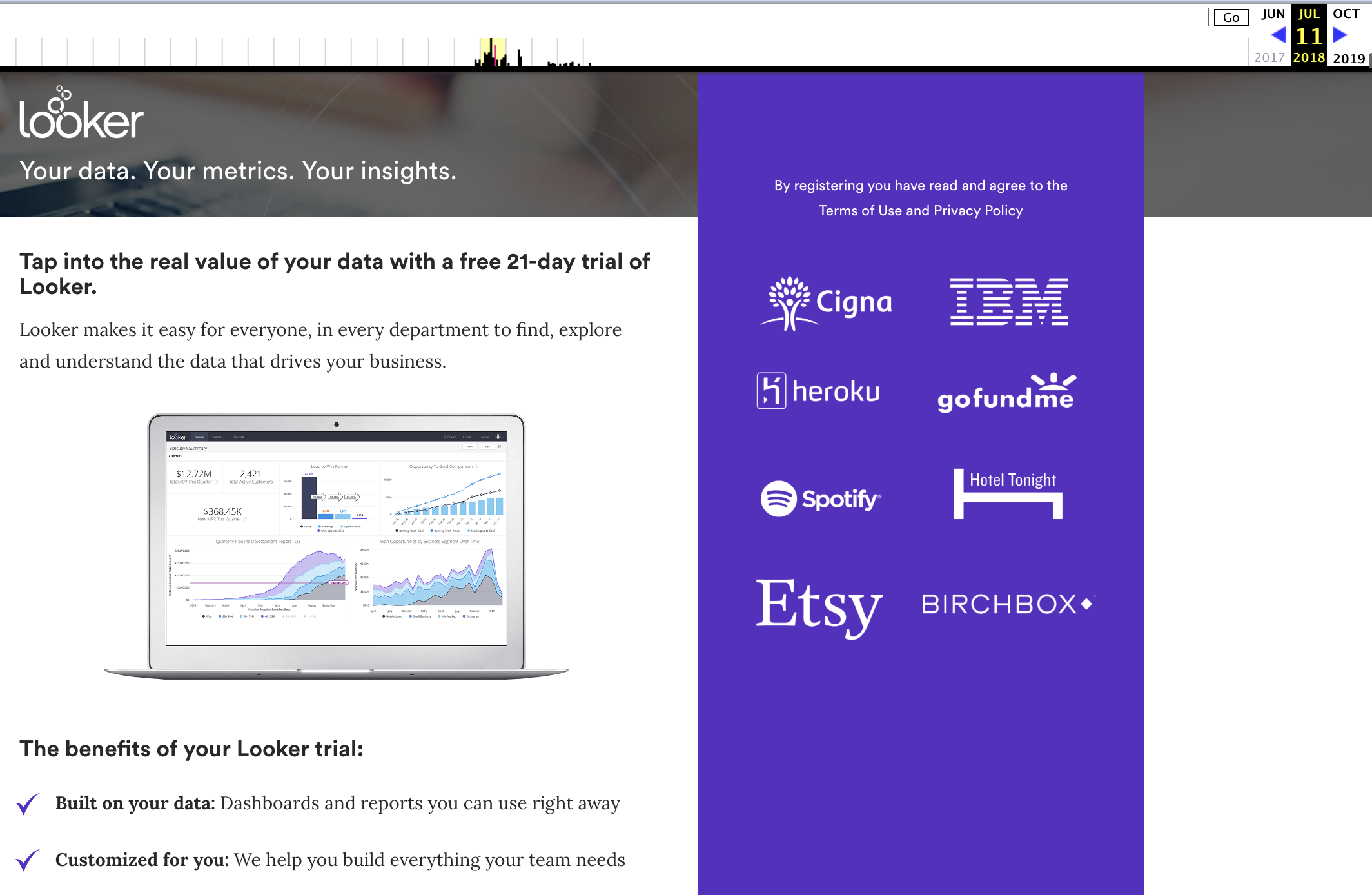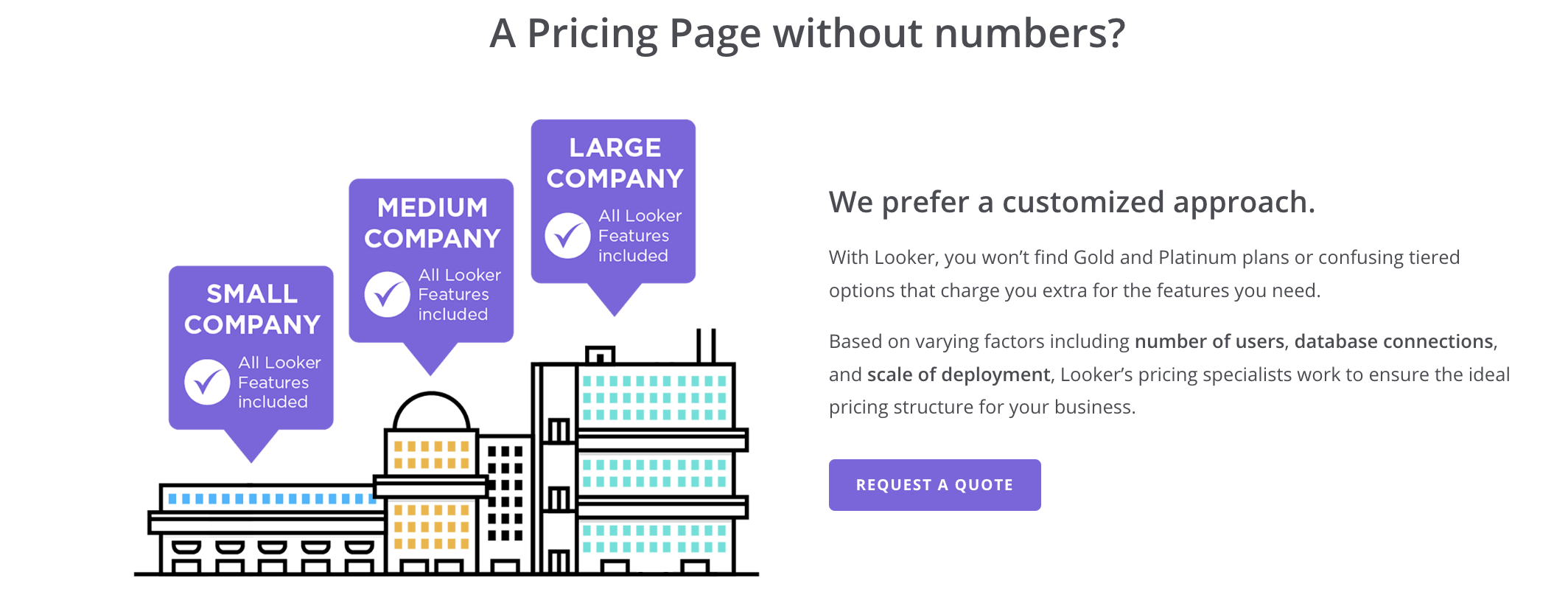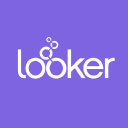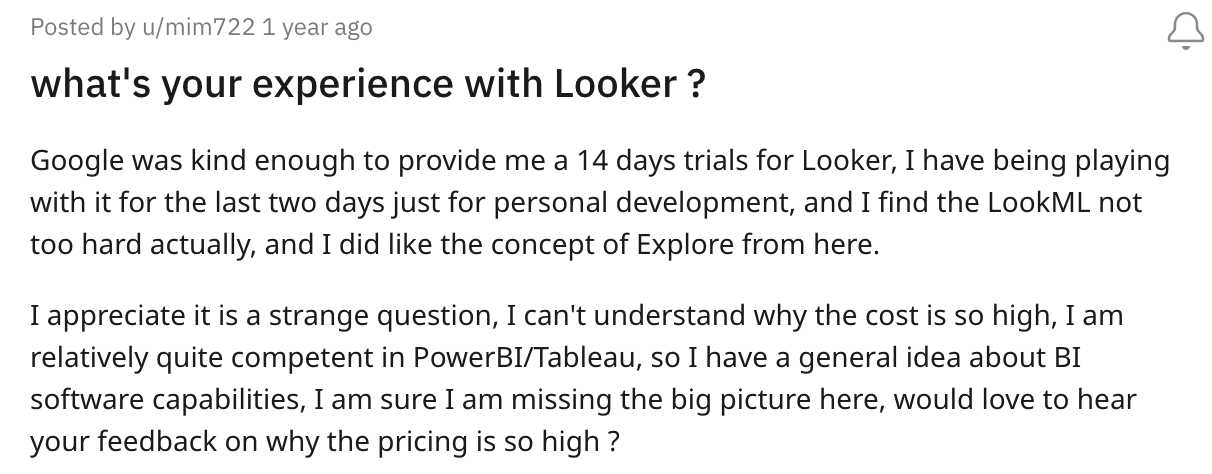Looker Pricing: Everything You Need To Know (2025)

Contents
Over the years, Looker pricing has become something of an enigma. No matter how hard to find, there's always a curtain drawn over it.
People made (educated) guesses, asked Reddit, and posted on Quora, but no one really knows the deets. So we set out to trace back everything related to Looker pricing floating around cyberspace, synthesize them here, and tell you about it.
Here's everything we know about Looker pricing.
(In case you don't have time and want a short answer, Looker Pricing reportedly starts at $60K/year)
1. They used to have a 21-day free trial
Back in 2018, and before that, you could request a free trial on Looker.
You would then jump onto a brief introduction call and product demo with Looker reps so that they could learn more about your analytics needs.

During your trial, you'll also have full access to our support team and most of Looker's features and functionality.
What changed: Looker no longer offers a free trial and we can derive a few observations:
- Their service motion is now sales-led. You need to request a demo and get on a call with their sales team before you can have a try at the product.
- They cater more to enterprises (which is pretty self-explanatory). You can negotiate for a small-business discount, but you’d need to work with your salesperson to structure your Looker package to what you need.
Now, on their pricing page, Looker also offers three platform editions. To know the exact amount for all of these plans - you'd have to go through Sales.
- Standard: Looker (Google Cloud core) is designed for small teams or organizations with fewer than 50 users. It includes one production instance, 10 Standard Users, 2 Developer Users, and upgrades, and allows up to 1,000 query-based and 1,000 administrative API calls per month.
- Enterprise: Looker (Google Cloud core) with added security for diverse internal BI and analytics needs. It comes with one production instance, 10 Standard Users, 2 Developer Users, upgrades, and supports up to 100,000 query-based and 10,000 administrative API calls per month.
- Embed: Looker (Google Cloud core) for deploying and managing external analytics and custom apps at scale. It includes one production instance, 10 Standard Users, 2 Developer Users, upgrades, and offers up to 500,000 query-based and 100,000 administrative API calls per month.
2. How Much Does Looker Cost? A Pricing Explanation
Back in 2018, on the Looker pricing page, it said that Looker pricing is based on varying factors, including the number of users, database connections, and scale of deployment.

Take a look at various community posts on Slack, Reddit, Quora, here's what we know:
- Looker’s starting price used to be around $35K per year (about $2,900 a month), but that was from four years ago, so you’ll need to account for inflation since then.
- Add-on: $30 for dashboard viewers, $60 for dashboard creators, and $120 for developer (who can write LookML)
- The $35K threshold has been around since 2018, so it's unlikely that the price point will be any lower in 2022 (especially when you take in the inflation). Though, it’s been said that you can negotiate with a Looker sales rep for a discount.


- Most companies with embedded analytics use cases skip Looker due to the high price for dashboard viewers ($30/viewer).
- Vendr, a vendor procurement software, also revealed that the maximum price for Looker software can reach up to $1,770,000, while the average cost for Looker software is about $150,000 annually.
Feel like Looker's humongous cost breaks your back? Check out the best alternatives to Looker
3. Looker Pricing Model (According to AWS Marketplace)
On AWS Marketplace, you can also find the “retail” pricing for Looker.
| Units | Description | 12 Months Cost |
|---|---|---|
| Standard - Platform | STANDARD - Looker Platform with 10 Standard Users, 24/7 Live Support | $66,600 |
| Advanced - Platform | ADVANCED - Standard Looker + 100k Query API Calls & 2 Looker Servers | $132,000 |
| Elite - Platform | ELITE - Advanced + 100k Admin API Calls & 8 Looker Servers | $198,000 |
| Add On - View User | Platform add-on user: view, filter, and schedule pre-made reports | $400 |
| Add On - Standard User | Platform add-on user: query modeled data - drill down+content creation | $799 |
| Add On - Dev/Admin User | Platform add-on user: build & administrate the data model | $1,665 |
For more information, check out this page.
Updated on February 18, 2025: In a recent Reddit discussion on embedded analytics tools, a Looker user stated the Elit package remains fairly consistent at approximately $180K list price, with potential for negotiation on discounts.

4. How Much Does Looker Embedded Analytics Cost?
According to this Reddit user, the Looker Elite license, which includes full embedding and custom visualizations, is listed at $180,000, with negotiable pricing available.

5. Looker Pricing Estimation
According to Vendr, a SaaS Purchasing Platform, the maximum price for Looker can reach up to $1,770,000. Their data, based on 355 deals procured via Vendr, revealed that the average cost for Looker software is about $150,000 annually, or around $12,500 monthly.

6. Not Ready For Looker Pricing? Check out other Looker alternatives
Other than the hefty price point and steep learning curve (with LookML setup), Looker is a great BI tool - you should go for it if you have the budget.
That being said, Business intelligence tools shouldn't break banks and your analytics efforts shouldn't get bogged down by eye-watering costs, especially amidst our current economic climate.
Cruise around analytics communities for a couple of minutes and you can easily find comments like this one where data teams voicing their discomfort with Looker's price point:



Here are some of the most budget-friendly Looker alternatives oft-mentioned by analytics communities:
- Holistics: A self-service business intelligence platform offers a semantic layer with LookML-like language, Git version control, and self-serve analytics. Here's a detailed comparison between Holistics and Looker.
- Metabase: An open-source SQL editor and data visualization tool. Metabase has been viewed as “analyst-centric” as users can turn any SQL query into reports and dashboards.
- Lightdash: A BI & data visualization tool built on top of dbt. Positioned itself as an open-source alternative to Looker.
That said, if you are looking for something similar to Looker in both architecture and capacity, then consider Holistics. (full disclaimer: it's us!)
Alternative to Looker with Better Pricing? Holistics
Holistics and Looker are a very close comparison as both tools take a very similar approach to BI: code-based modeling layer with self-service data exploration.
Both tools are 100% cloud-based, provide a centralized data modeling approach for BI teams, and empower business users who don’t know SQL can do true self-service. Here's a quick demo.
Looker is generally more mature than Holistics in terms of analytics functionality, but Holistics is also catching up fast. Holistics follows the same philosophy of self-service BI through a code-based semantic layer as Looker while innovating on a few aspects:
- A more flexible canvas-based dashboard that solves 80% of complaints about Looker’s dashboard
- Building complex metrics in Holistics is easier and does not require users to jump through hoops. For example, calculating cumulative sum in Looker requires a derived table while it is a one-line code in Holistics’
window_sum/window_avgfunction. Another example is nested aggregation in Looker vs Holistics. - Common analytical functions (period over period, percent of total, etc with more coming) are 1-click operations without the complex LookML setup.
A downside of Looker is that it requires your data team to learn LookML (which can be expensive to hire or train), while Holistics provides a gentler learning curve toward setting up data modeling.
In short, if you are looking for a self-service BI tool similar to Looker, with the right mix of pricing and functionality - you might want to check out Holistics.
Here's how an ex-Looker user made the switch to Holistics.

What's happening in the BI world?
Join 30k+ people to get insights from BI practitioners around the globe. In your inbox. Every week. Learn more
No spam, ever. We respect your email privacy. Unsubscribe anytime.


